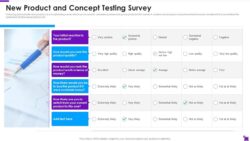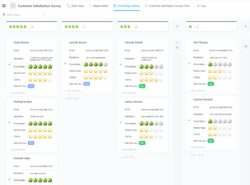Launching a new product into the market is an exhilarating journey, filled with ambition and innovation. However, it is also a path fraught with uncertainty. Will your brilliant idea resonate with consumers? Is there a genuine need for what you are offering? Without clear answers, you are essentially navigating uncharted waters, hoping for the best. This is where the power of direct customer feedback becomes not just beneficial, but absolutely crucial for de-risking your venture and ensuring your hard work truly hits the mark.
Imagine having a crystal ball that shows you exactly what your future customers want, what they are willing to pay, and what features they value most. While a real crystal ball is out of reach, a well-designed potential new product survey template is the next best thing. It allows you to gather actionable insights directly from your target audience, helping you refine your product concept, validate your market assumptions, and build something people genuinely desire. This guide will walk you through the essential elements and best practices for creating and utilizing such a powerful tool.
Crafting Your Ideal Potential New Product Survey
The foundation of a successful product launch lies in understanding your potential customers, and a comprehensive survey is your direct line to their thoughts and needs. It is not just about asking questions; it is about asking the right questions in the right way to unearth valuable data. Think about the specific uncertainties you face regarding your product idea. Are you unsure about pricing, features, or the core problem it solves? Your survey should be meticulously designed to address these very points.
Starting with broad questions about consumer pain points can lead to unexpected discoveries, guiding you towards solutions you might not have considered. Then, gradually narrow down to specifics about your proposed product. Remember, the goal is to get inside the minds of your audience, to see the world through their eyes and identify where your product fits into their lives, or how it can improve them. A thoughtful flow ensures respondents stay engaged and provide comprehensive answers, making your potential new product survey template genuinely effective.
One common pitfall is asking leading questions that bias responses. Always strive for neutrality to get the most honest and unfiltered feedback. For instance, instead of asking “Don’t you agree this new feature is amazing?”, try “How useful do you find this new feature on a scale of 1 to 5?”. The wording of your questions dramatically impacts the quality of the data you collect, making clarity and impartiality paramount for an effective potential new product survey template.
Key Elements to Include
- Demographic Questions: Understand who your respondents are (age, location, income, occupation) to segment your data later.
- Problem Identification: Questions that explore challenges or pain points your target audience currently experiences.
- Solution Appeal: Gauge interest in your proposed product as a solution to those identified problems.
- Pricing Sensitivity: Understand what respondents are willing to pay for your product or service.
- Purchase Intent: Directly ask about their likelihood to purchase if the product were available.
- Feature Prioritization: Allow respondents to rank or select features they find most valuable.
- Open-ended Feedback: Provide space for qualitative comments, allowing respondents to share thoughts not covered by specific questions.
Implementing and Analyzing Your Survey Results
Once your meticulously crafted survey is ready, the next step is distribution. Reaching the right audience is just as important as the questions themselves. Consider various channels: email lists of potential customers, social media platforms where your target demographic spends time, or even embedding the survey on your website. The broader your reach within your target segment, the more robust and reliable your data will be. Remember, a survey is only as good as the responses it gathers, so actively promoting it is key to its success.
Encourage participation by explaining the purpose of the survey and how their feedback will directly contribute to shaping the product. Offering a small incentive, like entry into a draw or a discount on the future product, can also significantly boost response rates. It is crucial to collect a diverse range of opinions from within your target market to avoid tunnel vision. If you only survey early adopters, for example, you might miss insights from a broader consumer base that is equally important for long-term growth.
After collecting the responses, the real work of analysis begins. This is where raw data transforms into actionable insights. Start by looking for patterns and trends in quantitative data, such as common preferences for features or price points. Identify any significant outliers and consider why those might exist. Qualitative data, from open-ended questions, requires a different approach; read through comments to identify recurring themes, sentiments, and any surprising feedback that might challenge your assumptions.
The goal is to translate these insights into concrete next steps for your product development. Perhaps your survey reveals a strong demand for a feature you had not prioritized, or it might indicate that your initial pricing strategy is off the mark. This data should inform iterations, helping you pivot or refine your product to better meet market needs. It is an iterative process, where feedback leads to adjustments, which might then lead to further testing, ensuring you are building a product that truly resonates and succeeds.
Gathering direct feedback from your target audience through a well-structured survey is an indispensable step in the product development lifecycle. It empowers you to make informed decisions, mitigate risks, and build offerings that genuinely solve problems and delight customers. By systematically collecting and analyzing these valuable insights, you lay a strong foundation for launching a product that stands the test of the market.
Embracing this customer-centric approach means your innovation is not just based on brilliant ideas, but also on validated demand. It is about co-creating with your future users, ensuring that when your product finally reaches them, it feels like it was designed specifically for their needs. This strategic foresight transforms uncertainty into opportunity, paving the way for sustained success and meaningful impact.

